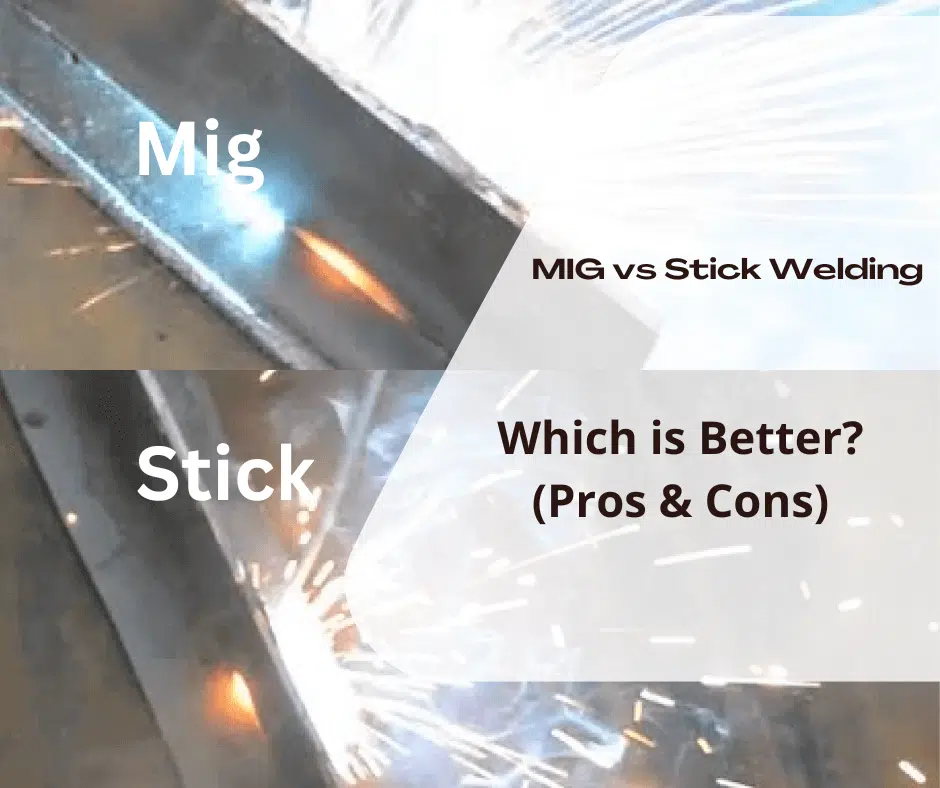
MIG vs Stick Welding: How do they compare? Where do MIG and stick welding diverge, and what do they have in common? In MIG welding, an instrument called a spool gun is used to feed an electrode wire through the welding process.
Instead, stick welding employs a detachable stick electrode that constantly travels through the welder. At the same time, a stream of gas is released, protecting the weld from oxygen and nitrogen.
Stick welding is a more traditional method, but because of its flexibility, it is typically the preferred or even required method for professional work.
Modern arc welding (MAG) is a more recent technique made possible by developments in electricity.
Before settling on welding equipment for your project or workplace, weighing the benefits and drawbacks of the two most common welding processes is essential.
This post will compare and contrast MIG welders and stick welders, discussing their respective advantages and disadvantages to help you choose the tool and method that will best serve your welding needs.
In addition to the more traditional MIG and stick welding, other methods, such as TIG welding, laser welding, and flux core welding, should be considered.
A wire welding electrode is used in MIG welders. It is run through the machine automatically on a spool at a constant pace. An arc is formed when an electrical current from a MIG welder travels between the wire and the metal base.
When an electric current flows through a wire, it generates so much heat that the wire and the metal base melt together, forming a junction.
It’s a relatively tidy process that doesn’t need much cleaning up once welding is done. MIG welding may take longer to set up than stick welding, but it produces cleaner, more precise welds that need less finishing work.
It takes around two weeks to learn the fundamentals of metal inert gas welding, often known as MIG welding. However, experienced welders may discover the procedure faster. Choosing the suitable shielding gas and learning how to adjust the settings on the welding equipment are two of the most important things to know when starting with MIG welding.
Learning the welding process, which works like a hot glue welding gun to create a high-quality weld with a clear, defined outcome, comes next once you’ve mastered these fundamentals.
This welding technique yields strong welds that don’t need considerable post-use cleaning or sanding. Welding using a MIG machine allows for more control and precision. It may be used on various metals and metal thicknesses (including stainless steel, filler metal, and thinner metal).
When working with different metals, getting acquainted with the setup requirements, such as the types of gases and wire spools needed, is essential.
The process of MIG welding might be complicated by the necessity to master different combinations of different metals and tasks. On the other hand, modern welding equipment includes automated setup functions that make MIG welding technology easier for novice welders.
If you want precise results from MIG welding, use it on smooth, clean, thin, or thick metals. MIG welding equipment should be set up and used in a controlled area, such as a factory, warehouse, or similar structure.
Although MIG welding may be done outside, the gases necessary for the process might make it challenging to work in the open air. In addition, it is essential to have a clean surface devoid of dirt, debris, or leftovers from prior materials or components, such as rust, paint, or residue.
The advantages of MIG welding are discussed. Depending on the job, the metals used, and the welder’s skill, MIG welding is typically the ideal method.
Welders of all skill levels may benefit from using MIG welding. Still, there are certain negatives to keep in mind before investing in the necessary equipment.
Stick welding, or arc welding, is one of the traditional welding procedures.
A charged metal stick generates a high-temperature arc, which transfers an electric current from the welding stick to the metal, fusing the two.
Stick welding has been used for millennia and is often regarded as the dominant technology because of its adaptability and durability. In addition, home welders, small businesses, electricians, and other tradespeople with similar workplaces sometimes favor stick welding for various reasons.
Stick welding is one of the most effective ways of welding joints and alloys; it is simple to use, even outdoors, and it is resistant to weather fluctuations, including wind. However, stick welders need more time than other welders to get up to speed since striking and maintaining a constant arc is difficult until it becomes second nature.
It’s a versatile welding technique that can be used on various metals and doesn’t break the bank. Even surfaces with residue, corrosion, or filth might benefit from this method. Stick welders are offered a choice of current types, including AC/DC, AC, and DC, with AC input being the most affordable. Welding of this sort is often employed by homeowners and handypersons, as well as by farmers and others working in the agricultural industry.
Stick welding is an excellent method for various tasks and materials since it can be performed in multiple situations without requiring special equipment.
When considering stick welding for a project, one must know some of the challenges inherent to the method.
Stick welding and metal-inert-gas welding have several commonalities.
Both methods use a shielding gas in an arc welding process to keep contaminants out of the weld pool. It takes experience, but MIG and stick welding are the two most reliable ways to create strong welds. Quality outcomes from MIG and stick welding need frequent replacement of the electrode, a consumable.
It may seem at first glance that MIG welding and stick welding are essentially the same things, but there are important distinctions to keep in mind. Each welding technique is effective, but MIG and stick welders have distinct features that make them more suited to specific jobs.
Stick welding is the most practical choice for amateurs since it is less expensive and more straightforward to learn than other welding techniques. However, it may take some time and effort to sand and scrape the area to enhance its appearance after completion, and the result may not seem clean at first.
Stick welding is an ancient technique, but MIG welding uses current technology for large-scale tasks in various settings.
Stick welding is excellent for novices, but it takes longer to finish some welding operations than MIG welding and isn’t as clean. Even though MIG welders are more sophisticated and need more knowledge to set up, they are extensively used in indoor and outdoor construction and industrial environments.
Stick welding, on the other hand, is best done in a controlled environment, preferably inside, where temperature and humidity swings are kept to a minimum. Welders with extensive expertise should use MIG welding, while novices should start with stick welding.
In need of welding advice for a new project or structure, you want to construct?
Sunbelt Rentals has everything you need to get the job done, including plasma cutters, welding machines, and anything from MIG welders to stick welding equipment.
We use only high-quality welding equipment that reliably delivers outstanding results. In addition, we repair and maintain our machines regularly to guarantee that this never changes.
Our knowledgeable staff can help you decide between MIG and stick welders, giving you the information you need to make a well-informed decision when renting a workspace. For example, suppose you’re just starting in the welding industry. In that case, stick welding is a great alternative. In contrast, MIG welding equipment is better suited for more complex projects and pieces of equipment.
You may avoid expensive repairs and purchases by renting welding equipment from Sunbelt Rentals, where our service staff is available by phone and online for all your servicing requirements. Our service includes all the equipment and materials required for a smooth and efficient setup.

M Hasan
I’m a professional welder and a writer at heart, so I wanted to share the welding expertise I’ve gathered over the years. In addition, I hope our posts motivate others to start welding. I have well-researched. I promise you’ll find honest advice on choosing the best MIG welder here- www.migweldercart.com
Read My Reviews On The 10 Best Mig Welder.
Disclaimer:
MigWelderCart.com provides content for informational purposes only and does not guarantee the accuracy or reliability of the items featured. We may earn commissions from qualifying purchases through the Amazon Associates Program and revenue from Google AdSense ads. Third-party vendors, including Google, use cookies to serve ads based on prior visits. Users can opt out of personalized ads via Google Ads Settings. All trademarks, brands, and images belong to their respective owners, and usage is at your own risk.